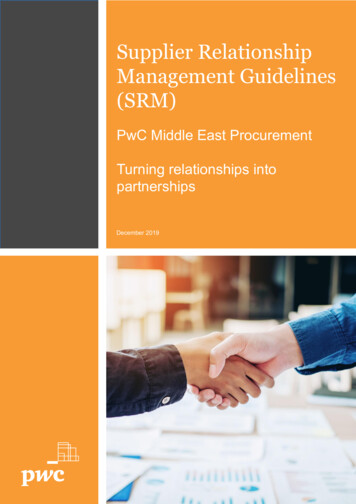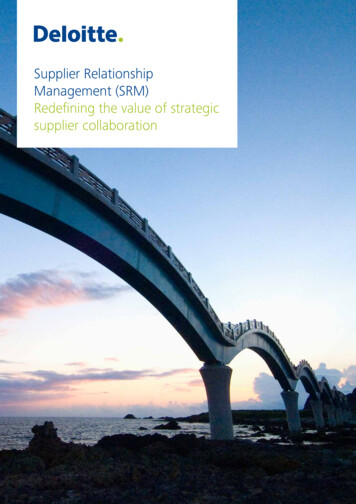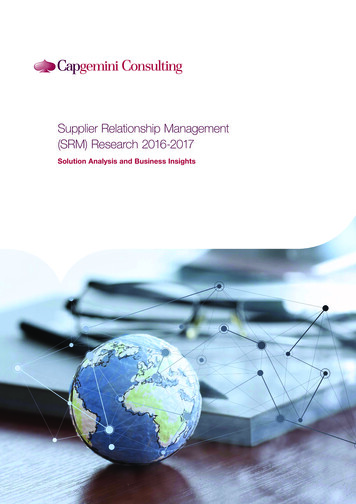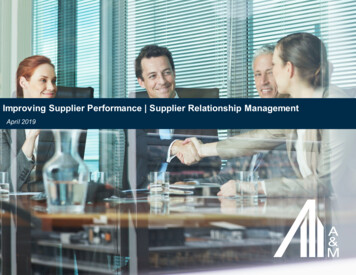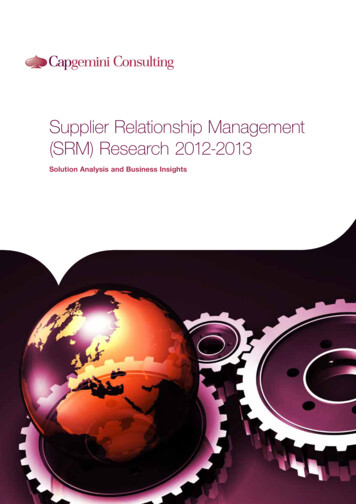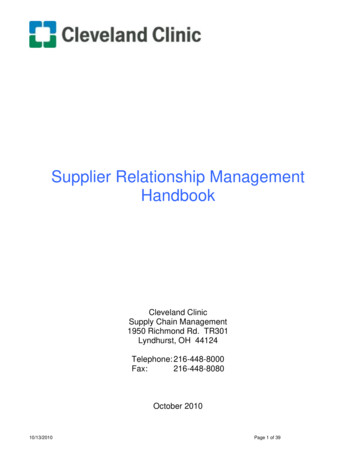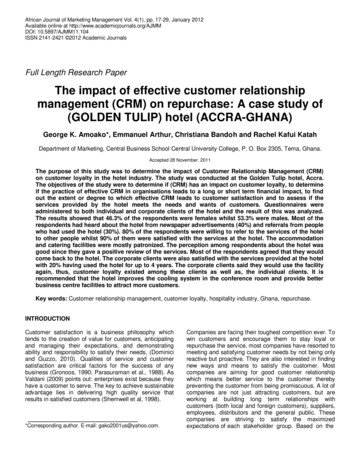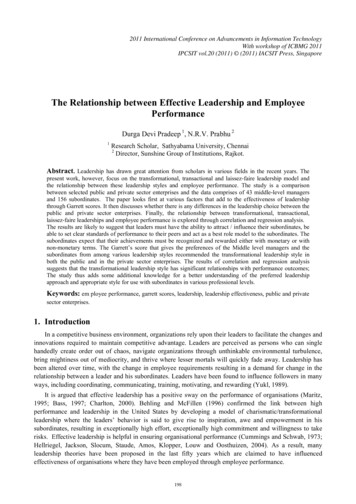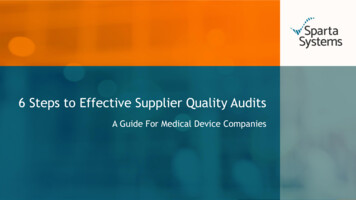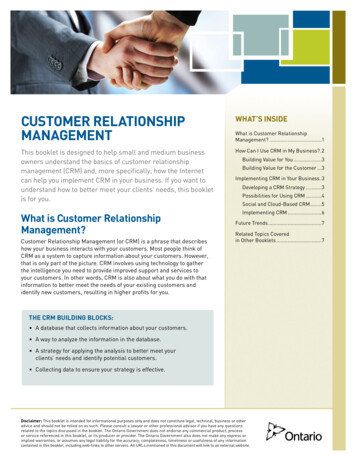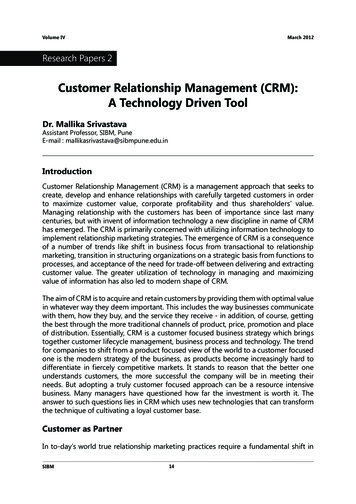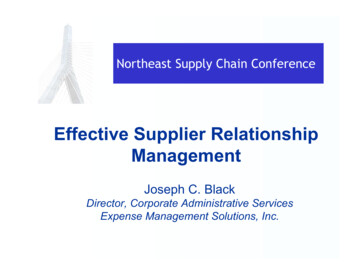
Transcription
Northeast Supply Chain ConferenceEffective Supplier RelationshipManagementJoseph C. BlackDirector, Corporate Administrative ServicesExpense Management Solutions, Inc.
Presentation Outline Importance of Supplier RelationshipManagement The Required Foundation Supplier Segmentation Managing Supplier Relationships2
Importance of SupplierRelationship ManagementWhat is the goal of Supplier RelationshipManagement?Achievement of desired results(e.g. best product and/or best service, deliveredcost effectively)Ultimately- client satisfaction3
Importance of SupplierRelationship ManagementWhy do supplier relationships fail?4
How Relationships WorkImproveMutualUnderstandingConfirmSuspicions /PerceptionsRestrictInformationFlowCreate LowValue DealUnder-investin RelationshipDoom tionsImproveTrust andCommunicationVirtuous Cycle
Two Views of RelationshipManagementCommon assumptionsBetter assumptions A good relationship can/must be bought Deal with them the way they deal withus The bottom line sometimes requiressacrificing the quality of the relationship A good relationship needs to be built, itcannot be bought Do what is good for the relationship, andus, regardless of whether or not theyreciprocate A strong relationship is essential tosustainable bottom line resultsCommon measuresMore robust measures You do what I want I keep you happy We have little or no conflict Communication is robust and efficient Tensions are surfaced early and easily We trust each other We understand and respect each other,even when we don’t agree We rely on persuasion rather thancoercion6
The Required FoundationWhat do you need for a strong supplierrelationship?7
The Required Foundation Fully executed, comprehensive supplieragreement Aligned objectives Clearly defined statement of work Measurable service expectations8
The Required Foundation Effective Supplier Management Program Clearly defined measuresDocumented method of measurementWeighted individual measuresMinimum/threshold gatesLink to compensation9
The Required Foundation Skilled Relationship Managers Managers of relationships (supplier/client), notfunctions Subject matter experts, credible Masters of communication Enablers (solution driven, not fault driven) Integral, honest and appropriately biased10
Supplier SegmentationDoes one approach to Supplier RelationshipManagement work for all?11
Segmentation Benefits Ensures optimal allocation of limitedmanagement time and resources Helps determine what kind of relationshipto develop for different types of suppliers Ensures internal alignment re: suppliermanagement roles, responsibilities,actions12
Segmentation Benefits Guides sourcing and negotiation strategy,relationship management structure andsupplier activity Helps clarify and manage supplierexpectations13
Segmentation Criteria Degree ofinterdependence(customer/supplier) Level of spend Strategic importanceof supplier Number of BUsserved by a supplier Complexity andfrequency of changesin supplierrequirements Type and number ofproducts or services asupplier provides Cost/difficulty ofswitching suppliers14
Segmentation ModelValue at stake/strategic ipHIGHLOWCost/difficulty of switching suppliers
Segmentation rategyMaximize priceleverageSole sourceMaximize value;lowest total costLeverage number ofsuppliers andbusiness volumeawardedPresumedDurationShort to mediumtermDependent onmarket modity groupportfolio managerCommunicationLimited totransactionalexchange of infoQualityManagementManaged onexception basis;leverage penaltiesPlanningAnnual; narrow inscopeSupplier’sViabilityInvestment inRelationshipN/ALowMedium to longtermCritical need“Win/Win”maximize joint gainand good precedentLong termDedicatedJoint customerrelationshipsupplier oversightmanager; internalDedicatedboard; dedicatedcustomerrelationship managerrelationship managercoordinationcommitteeRobust and frequent, Robust and multiRegular, thoughwith some executivelevel, with seniorlimited in scopecontactexecutive contactJoint effort;Managed oncustomer investmentJoint effort, equalexception basis;driven by switchinginvestmentleverage incentivescostsJoint and frequent; Integrated, frequent,Regular, but limitedand long termtime horizon variesin scopefocusedby contextSafeguard whenUnderstand andSafeguardbenefits outweighmonitorcostsMedium to lowMediumHigh
Managing SupplierRelationships“We outsourced it. It’s the supplier’sproblem, not mine!”17
Supplier Relationship Management Paradigm ShiftAttributes of a typicalcustomer-vendor relationship “This is about getting them to meet our needs”Attributes of astrategic supplier partnership “This is about meeting both our needs in asustainable way” When things go wrong, assign blame and applycontractual penalties When things go wrong, diagnose jointcontributions and work to avoid repetition Customer decides, vendor executes Wise decisions need joint input Customer defines metrics; supplier is evaluated At least some metrics are jointly developedand shared, or symmetrical Negotiations are often adversarial; producearbitrary outcomes Negotiations focus on problem-solving;produce good precedents Each party is often surprised and learns ofdecisions after they’re made Surprises are rare; planning is highlyintegrated; communication is frequent androbust
Stronger RelationshipsGenerate More Value * Almost 80% of respondents saidthat strong workingrelationships with suppliersdeliver at least 25% greater valuethan poor relationships withsuppliers. Procurement professionalsreport that they would increasetheir company’s bottom line by 43 million annually if they wereto implement strategicrelationship managementpractices with key suppliersIncremental Value GeneratedThrough Strong Supplier Relationships9%20%17%33%21%0-25% more value76-100% more value26-50% more value 100% more value51-75% more value* Source: Negotiating and Managing Key Supplier Relationships: A Cross-Industry Study of 20 Best Practices. Vantage Partners, 2003.
Good RelationshipCharacteristics ValueCharacteristics of a good relationshipDimensions of relationship value High degree of trust Reduced compliance monitoring costs Robust and efficient communication Reduced transaction costs of working together Collaborative and creative problem solving High degree of mutual understandingGreater value through improved leveraging ofassets and capabilities Conflicts and tensions are surfaced early Fewer damaging or costly surprises Differences in goals, culture, andcompetencies are respected Greater value through low-cost, high valuetrade-offs Disagreements are resolved through mutualpersuasion, not coercion Reduced switching costs Emphasis on diagnosing joint contribution– not assigning blame Problems spotted early (before significant costsare incurred) and resolved effectively
Ongoing Management SustainsValue Demand management Market management (benchmarking) Supplier management21
Benefits of SupplierRelationship Management Minimize supplier-related risks Maximize opportunities to reduce/avoidcosts Capitalize on potential synergies revealedthrough greater integration betweensupplier and client Maximize client satisfaction Maximize client investment in supplierrelationship22
Benefits of SupplierRelationship ManagementAchievement of desired results(e.g. best product and/or best service, deliveredcost effectively)Ultimately- client satisfaction23
Effective Supplier RelationshipManagementTHANK YOU!Joseph C. BlackDirector, Corporate Administrative ServicesExpense Management Solutions, Inc.144 Turnpike Road, Suite 330Southborough, MA 01772508/460-7014black@expensemanagement.com24
Effective Supplier Relationship Management THANK YOU! Joseph C. Black Director, Corporate Administrative Services Expense Management Solutions, Inc. 144 Turnpike Road, Suite 330 Southborough, MA 01772 508/460-7014 black@expensemanagement.com. Title: Microsoft PowerPoint - Black -EMS.ppt Author : Chao-Ming Ying Created Date: 9/8/2005 12:02:36 AM .File Size: 755KBPage Count: 24

